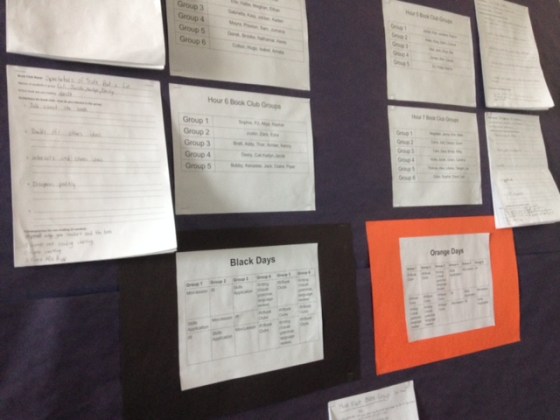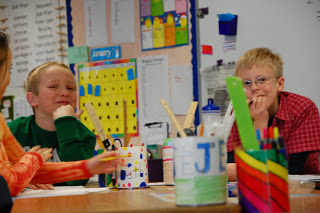
While my district gathers information as we try to determine what the fall can look like my wheels have been spinning. While I may not know whether I will be in a hybrid setting or completely virtual, I know that it will not be school as usual and so a huge question I am wrestling with is how do I translate what we do as a community face-to-face into this new mode of teaching? How do I continue to center our classroom on reading and writing identity when we won’t have the same opportunity for daily discussion and community exploration? When I won’t be right there to kid-watch and adjust my instruction and care of them accordingly?
Every year our readers’ notebooks become a trusted place for many of our students to reflect on who they are as readers, how reading impacts them, and how reading fits into their lives. It is all-year work that ties in with the overall focus on identity, how they see the world, how the world sees them, and how our lens of the world impacts our action. It is at the heart of what we do and yet, this year, I don’t know when I will be with them to do this work. How do we still do meaningful work in our notebooks without kids having to upload every image into our learning hub, how do we center our work in our identity and see how we grow throughout the year?
Enter digital notebooks which really are just fancy templates to make slide shows look like notebooks as my husband pointed out. And yet within the fancy template also comes a familiarity. These templates look like the notebooks we would use with kids, they can be organized in ways that will hopefully make it easier for kids to navigate the work and will ground our work for the year whether we are face-to-face or online.
And so last night, I created a digital notebook for our reading identity work based on a template created by Laura Cahill and while it is a work in progress I wanted to share it here as I know a lot of people are trying to wrap their heads around this work as well. As I write this, my former students are assessing it to give me feedback, I have also asked for feedback from other educators. I know it could be better, I know that collaboration will always improve my teaching.
In this work, I also know that I need to be careful with my students’ reading lives. That year after year they tell me how much they hate to write about their reading, how when we attach to-do’s to their reading it becomes a chore rather than a journey. That when we are constantly asking kids to prove that they are reading they start to not read. This is not anything new, I have written and shared the words of my students for years and it grounds me in every decision I make as the teacher who starts our journey and guides it throughout our year.
With this in mind, I had components in my instruction that I wanted to address as I created this tool.
How will I support kids through this tool? Each component is a separate lesson that we place the foundation for in the beginning of our year together and then return to throughout the year. I have written about all of them on this blog throughout the years as well as gathered all of my thoughts in my book Passionate Readers. So when I ask students to use their to-be-read list or reflect on who they are as a reader, they are not going into this unsupported, instead we weave lessons throughout these conversations such as about our reading journey, which emotions tied in with reading we carry, and many other things. It is also so much bigger than this notebook, this is work embedded in the conversations we have, the media we surround ourselves with, the quiet reflections, the surveys, the connections, the trust, the community, and everything else that we do with the realizations and questions we have. Please do not think that this notebook is all we do or encapsulates all of the work that happens throughout our year, it can’t be and it won’t be.
How will I know whether they are actually reading? I won’t. That comes down to trust, where they are on their journey, as well as which role reading plays in their life. There is no single tool that is worth me implementing for all kids that may not cause more long-term damage to their reading identity. When we are face-to-face, I usually have kids sign in for attendance with their page number that day, this allows me to get a quick glance at their reading that then is deepened in our reading conferences, that is not a fully viable option this year. So instead, the “Accountability” tab offers them an option to choose a way to show me when they have finished a book, and the “Reading data” tab gives them a way to keep track of what they are reading. I will be stressing to kids that their reading data is not meant to capture every minute or page read like a traditional reading log would, but instead to let them give a broad statement about their reading life the previous week. It is the two sections in particular I am still not loving, that will probably change as the year gets going and that I will be keeping a deep eye on as far as potential harm to reading habits. I also know that some kids will not want to use this reading notebook at all, that they would rather refuse than engage, so then that will simply be where we start our conversation. I will be utilizing reading check-in conferences as well, I am just not sure what they will look like yet since I don’t know my school year will look like. I will share my ideas for that when I have them.
How can we get ideas for what to read? Book shopping and surrounding kids with books is a cornerstone of what we do and kids need more than audio and digital books to really continue their reading journey. I have already written about ideas of how to help kids get books in their hands if in a hybrid or virtual learning environment and I will be sharing more ideas as I plan with our incredible librarian and other colleagues for when we know more. I know I will be doing live book talks whenever possible, but also dedicating time in our instruction for kids to book browse virtually, as well as continue to suggest books whenever I can to individual kids. Another idea that I am loving is that when students pick up or drop off books, we add extra books to the bag that they may also like, so that instead of just one or two books, kids get a bag of five or so.
How can students set reading goals that matter to them? For too long, I set the reading goals for my students. Luckily, I saw the light several years ago and I haven’t looked back since. Having students set meaningful reading goals, though, takes time. Many kids, even kids who have fantastic relationships to reading, want to hurry through the goal part and set it just so their teacher will check it off on their to-do-list. This is why setting a 6-week goal at a time and following it up with conversation will be so important in our year together. This is why our goal is not just focused on quantity but habits. Yes, they should read more than they have in the past if they can, but “more” encompasses many different things not just quantity. Kids can use the same goal for more than one round of 6-weeks as needed, some of my students work on the same goal all year. I just want to ensure that we have built in reflection time for the goals and will add dates when I know what my school year calendar looks like.
How will they develop their thinking about who they are as a reader? “Who are you as a reader?” is a question we have used for a few years now in our work with students. At first, many of my students have no idea what to answer, they don’t know necessarily what the question means or are not sure what I am looking for in their answer. That is why this is a year-long reflection question and one that we unpack together, especially because reading identity really just equals identity and so when I ask who are you as a reader what I am really asking is who are you? Since trust is something we build, I see a significant change in students’ responses throughout our year together.
While this is not a finished tool, it won’t be finished until we start using it because my new students will surely impact the work we do and how we do it. For now, this is my best draft and so I share it with the world in the sense of collaboration. That also means that you can certainly make a copy of it and use it, but please do not sell it or forget attribution. This is the work that I along with others have developed over several years. I am grateful that Laura Cahill shared the template for free, so this work is shared, as always, in the same spirit. Feel free to leave questions or comments for me.
To see the full reading identity notebook, click this link.
Also, if your district or conference are interested in bringing me in virtually throughout the school year, please see information here. I have been supporting teachers remotely as they plan for meaningful literacy instruction in a virtual and hybrid model throughout the summer and would love to help others as well.





